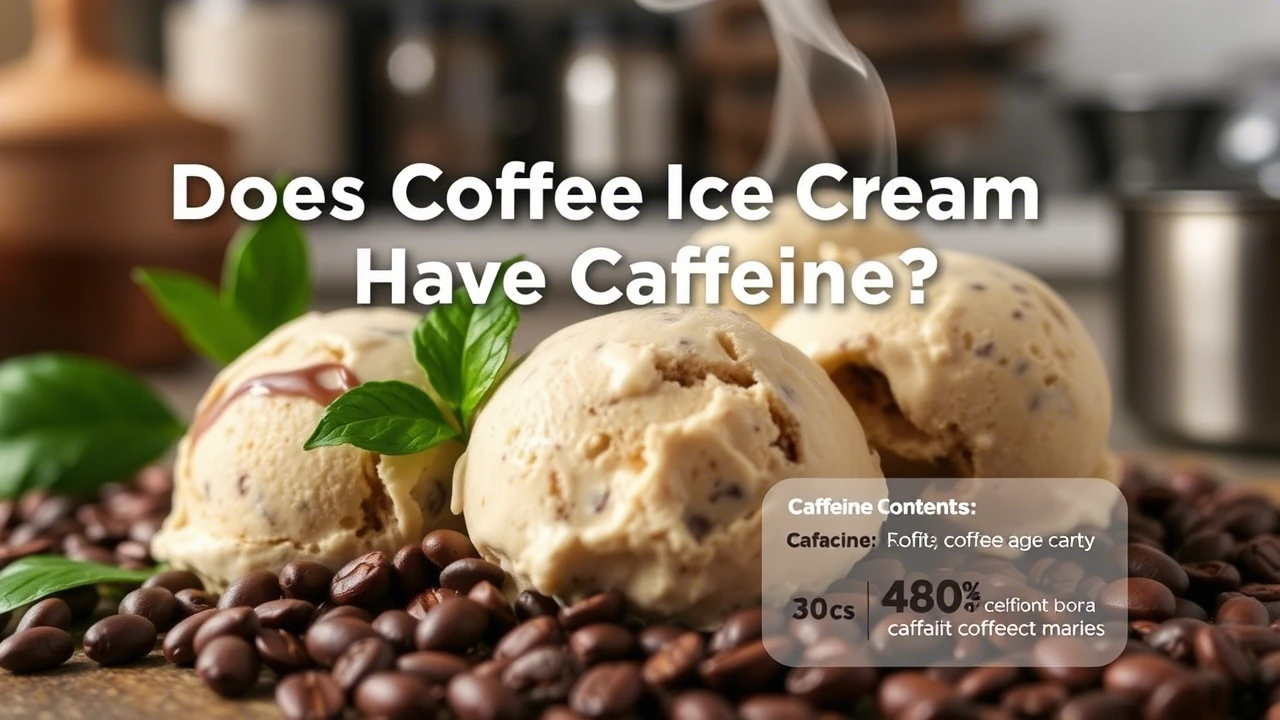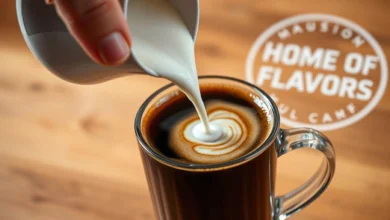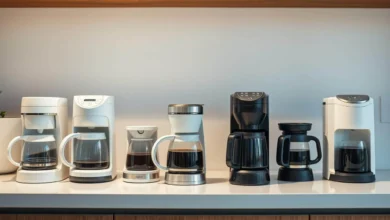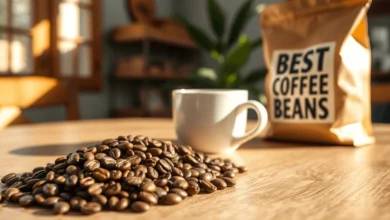You’re enjoying a cold scoop of coffee ice cream on a warm day. The taste of coffee mixes well with the sweetness of ice cream. But, have you wondered: does it have caffeine?
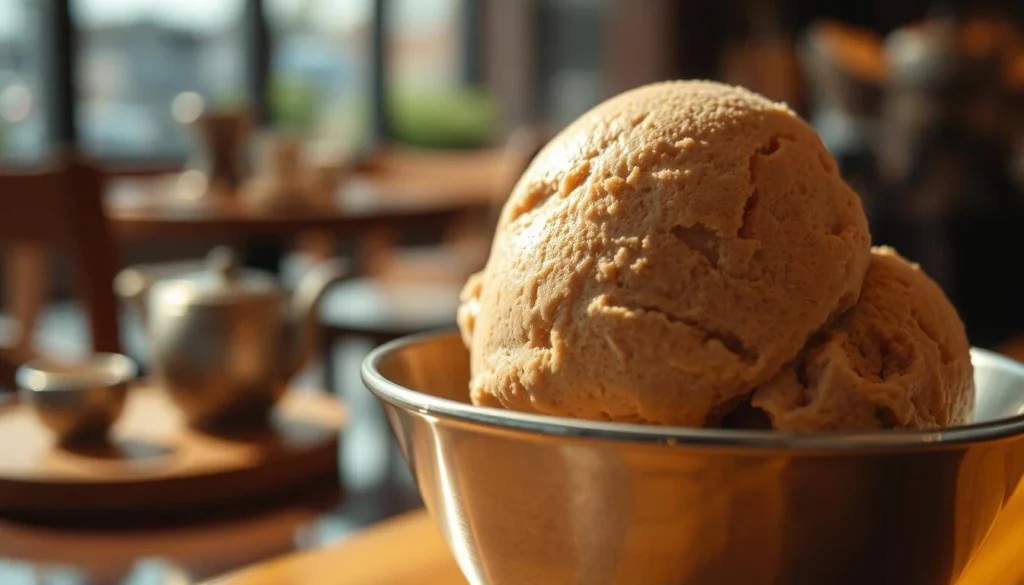
Table of Contents
For many, knowing if caffeine is in their favorite dessert is important. If you’re sensitive to caffeine, you might worry. Or, if you want a caffeine boost, you might hope it does.
In this article, we’ll look into the caffeine content of coffee ice cream. We’ll tell you everything you need to know.
The Truth About Caffeine in Coffee Ice Cream
Coffee ice cream is a favorite treat, but do you wonder if it has caffeine? The answer depends on what makes it “coffee-flavored” and where the caffeine comes from.
What Makes Coffee Ice Cream “Coffee-Flavored”
Coffee ice cream’s unique taste comes from coffee or coffee extracts. The type and amount of coffee can change between brands and recipes. Some use brewed coffee, while others might use coffee extract or espresso.
Sources of Caffeine in Coffee Ice Cream
The main source of caffeine in coffee ice cream is the coffee itself. Whether it’s brewed coffee, espresso, or coffee extract, these ingredients naturally have caffeine. The amount of caffeine in the final product depends on how much coffee is used.
For example, ice cream made with a shot of espresso will likely have more caffeine than one made with a small amount of brewed coffee.
Knowing where caffeine comes from in coffee ice cream helps you make better choices. Whether you’re sensitive to caffeine or just curious, understanding what’s in your coffee ice cream is important.
How Much Caffeine Is Actually in Coffee Ice Cream?
If you love coffee ice cream, you might wonder about its caffeine. This treat mixes coffee’s richness with ice cream’s creaminess. But how much caffeine does it really have?
Average Caffeine Content in Commercial Brands
A scoop of coffee ice cream usually has 30-45 milligrams of caffeine. This can change based on the brand and ingredients. Most brands use a set amount of coffee or coffee extract, keeping caffeine levels similar.
Comparing Coffee Ice Cream to a Cup of Coffee
A typical cup of coffee has 70-140 milligrams of caffeine. So, coffee ice cream has less caffeine than a standard cup of coffee. But remember, serving size matters for your caffeine intake.
Caffeine Content by Serving Size
The caffeine in coffee ice cream changes with serving size. A bigger serving means more caffeine, while a smaller one means less. Knowing your serving size is key to tracking caffeine.
Absorption Rate Differences
Also, think about how caffeine is absorbed from coffee ice cream versus a cup of coffee. Caffeine in ice cream might be absorbed slower because of cream and sugar. This could affect how it impacts your body.
Factors That Affect Caffeine Content in Coffee Ice Cream
The caffeine in coffee ice cream comes from how it’s made and what’s in it. Knowing this can help you enjoy your favorite ice cream more.
Production Methods and Ingredients
The type of coffee beans, how they’re brewed, and the recipe’s coffee amount affect caffeine levels. Real coffee vs. artificial flavoring is key.
Real Coffee vs. Artificial Flavoring
Ice cream with real coffee has more caffeine than fake flavoring. Using high-quality coffee beans means better taste and possibly more caffeine.
Coffee Bean Types and Processing
Arabica and Robusta beans have different caffeine levels. Arabica has less. The roast method also changes caffeine content.
Brand Variations and Formulations
Brands use different recipes and methods, leading to caffeine differences. Here’s a look at some popular brands:
| Brand | Caffeine Content (mg per serving) | Type of Coffee Used |
|---|---|---|
| Brand A | 20 | Arabica |
| Brand B | 30 | Robusta |
| Brand C | 15 | Blend |
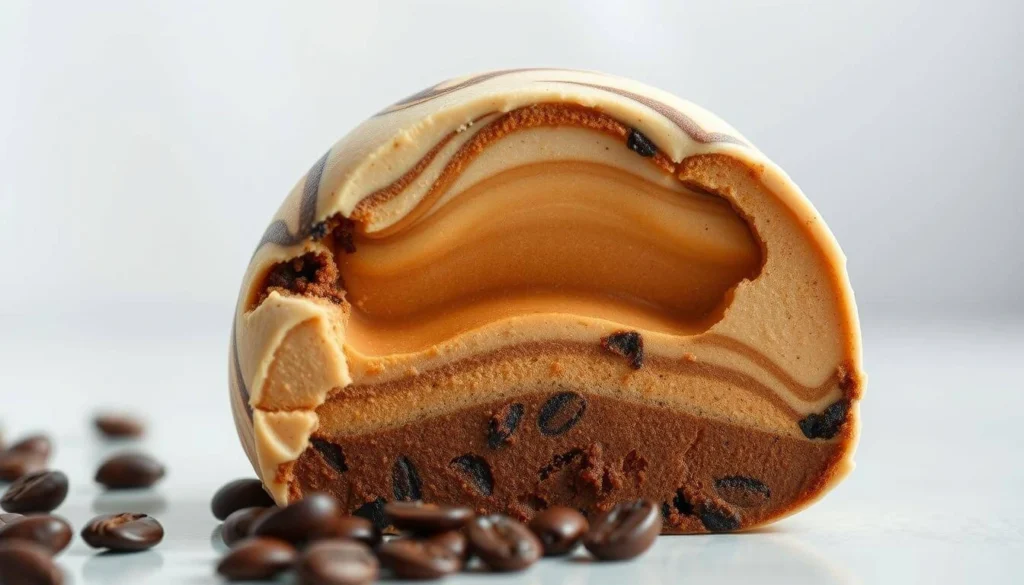
Understanding these factors helps you choose coffee ice cream wisely. This is important if you watch your caffeine intake.
Popular Coffee Ice Cream Brands and Their Caffeine Levels
Coffee ice cream’s caffeine content varies by brand and type. This is due to different ingredients, production methods, and formulations. Knowing these differences helps those watching their caffeine intake.
Major Commercial Brands Analysis
Major brands are easy to find and often list nutritional info. Let’s look at the caffeine in some popular ones.
Häagen-Dazs, Ben & Jerry’s, and Breyers
Häagen-Dazs’ coffee ice cream has 21.6 mg of caffeine per ½ cup. Ben & Jerry’s Coffee Coffee BuzzBuzzBuzz has 45 mg per ½ cup. Breyers coffee ice cream has less caffeine.
| Brand | Caffeine Content (mg per ½ cup) |
|---|---|
| Häagen-Dazs | 21.6 |
| Ben & Jerry’s | 45 |
| Breyers | 10-15 |
Store Brands and Budget Options
Store brands and budget options offer coffee ice cream with different caffeine levels. They provide affordable choices without sacrificing taste or quality.
Walmart’s Great Value coffee ice cream has about 15 mg of caffeine per ½ cup. It’s a low-caffeine option.
Specialty and Artisanal Coffee Ice Creams
Specialty and artisanal coffee ice creams have unique ingredients and methods. These can change their caffeine levels. Brands might use high-quality coffee or special brewing methods.
Some artisanal brands use cold brew coffee. This can have more caffeine than regular coffee. Always check labels or ask the maker for caffeine info.
Does Coffee Ice Cream Have Caffeine? Decoding Product Labels
If you’re worried about caffeine in coffee ice cream, start by looking at the ingredient list. Knowing what’s in your dessert can help you choose wisely.
Understanding Ingredient Lists
It’s key to check the ingredient list to see if coffee ice cream has caffeine. Words like “coffee extract” or “coffee flavoring” might suggest caffeine is present. But, it’s not a sure thing. You must look for caffeine terms or understand what the ingredients mean.
What “Coffee Extract” and “Coffee” on Labels Mean
“Coffee extract” means the product has a strong coffee flavor, possibly with caffeine. But, the caffeine amount can differ by brand and how it’s made. “Coffee” as an ingredient simply means it’s used, possibly adding caffeine to the mix.
Regulatory Requirements for Labeling
In the U.S., the FDA oversees food labels, making sure ingredients are listed correctly. But, it doesn’t always require the exact caffeine amount to be shown.
Hidden Caffeine Sources
Some ingredients, like cocoa or certain flavorings, might have a bit of caffeine. Knowing about these hidden sources can help you understand your caffeine intake from coffee ice cream better.
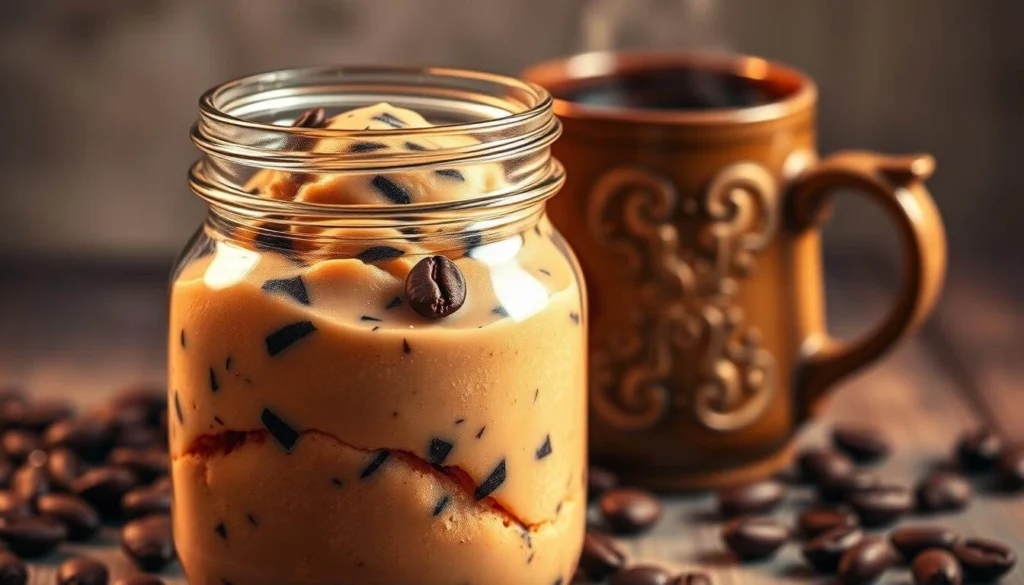
| Label Term | Caffeine Implication |
|---|---|
| Coffee Extract | May contain caffeine |
| Coffee Flavoring | May or may not contain caffeine |
| Cocoa | Small amounts of caffeine possible |
How to Choose Coffee Ice Cream Based on Caffeine Content
When picking coffee ice cream, knowing its caffeine level is key. This helps you enjoy your treat while watching your caffeine intake.
Questions to Ask Before Purchasing
Before you buy coffee ice cream, ask a few questions. What kind of coffee is used? Is it brewed, coffee extract, or espresso? How much caffeine is in each serving? Look at the ingredient list and nutrition label for answers.
Making Informed Decisions for Different Needs
People have different caffeine needs when it comes to coffee ice cream. If you’re caffeine-sensitive, choose ice creams with decaf or low coffee content. For those who want a caffeine boost, go for ice creams with more coffee or espresso.
For Caffeine-Sensitive Individuals
If caffeine bothers you, look for “decaf” or “low caffeine” labels. Some brands also share caffeine info on their packaging or websites.
For Those Seeking Caffeine Benefits
If you like caffeine’s kick, pick coffee ice cream with more caffeine. Brands using espresso or strong brewed coffee are good choices.
| Caffeine Level | Ideal For | Product Features |
|---|---|---|
| Low/Decaf | Caffeine-sensitive individuals | Made with decaffeinated coffee, minimal caffeine content |
| High | Those seeking caffeine benefits | Made with espresso or strong brewed coffee, higher caffeine content |
Health Considerations: Who Should Monitor Coffee Ice Cream Consumption
Enjoying coffee ice cream can be fun for many. But, some groups need to watch their caffeine intake. This is because coffee ice cream has caffeine that can be risky for certain people.
Children and Caffeine Sensitivity
Children are more sensitive to caffeine because of their smaller size. Eating coffee ice cream can give them too much caffeine. Parents should keep an eye on how much coffee ice cream their kids eat.
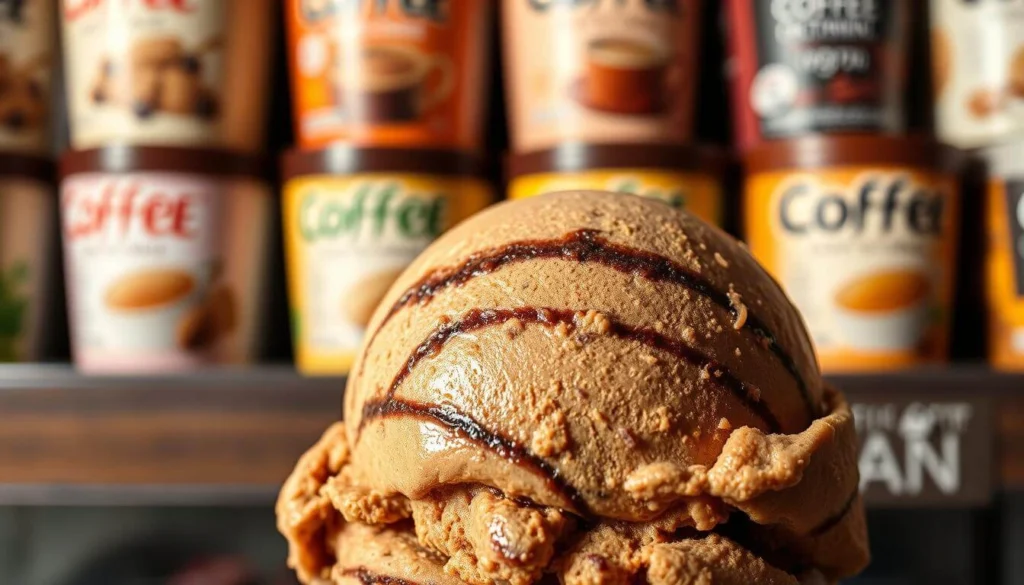
Pregnant and Nursing Women
Pregnant and nursing women should not have too much caffeine. Too much caffeine can harm the baby or affect the baby’s health through breast milk. It’s important for them to watch how much coffee ice cream they eat.
People with Caffeine Sensitivities or Health Conditions
People who are sensitive to caffeine or have health issues should be careful. Caffeine can make anxiety, heart problems, and sleep disorders worse.
Sleep Disorders and Anxiety
For those with sleep disorders or anxiety, caffeine in coffee ice cream can make things worse. It’s important to think about when and how much coffee ice cream to eat to avoid problems with sleep or anxiety.
Heart Conditions and Medications
People with heart issues or taking certain medicines should also watch their caffeine intake. Caffeine can affect how these medicines work or make heart problems worse. It’s important for them to be careful with coffee ice cream.
| Group | Caffeine Concern | Recommendation |
|---|---|---|
| Children | High sensitivity to caffeine | Limit or avoid coffee ice cream |
| Pregnant/Nursing Women | Caffeine affects fetal development or passes into breast milk | Monitor and limit intake |
| People with Caffeine Sensitivities | Caffeine can exacerbate health issues | Avoid or limit coffee ice cream |
How to Make Homemade Coffee Ice Cream with Controlled Caffeine
By making coffee ice cream at home, you can control its caffeine. This is great for those who are sensitive to caffeine. Or for those who want to enjoy it at any time without caffeine worries.
Recipes Using Regular Coffee
Using regular coffee in your ice cream ensures a rich flavor. You can adjust the coffee amount to control caffeine levels.
Hot Brew Method
The hot brew method brews a strong coffee with hot water. It extracts more oils, giving your ice cream a deeper flavor.
Cold Brew Method for Lower Acidity
The cold brew method steeps coarse-ground coffee in cold water for a long time. It results in a smoother, less acidic coffee flavor.
Recipes Using Decaffeinated Coffee
For caffeine-free options, decaffeinated coffee is a good choice. You can enjoy the rich coffee flavor without caffeine.
Basic Decaf Coffee Ice Cream
Making decaf coffee ice cream is similar to regular coffee ice cream. Just use decaffeinated coffee beans. This way, you can enjoy your favorite dessert without caffeine worries.
Coffee-Flavored Alternatives Without Caffeine
Looking for caffeine-free alternatives? Use coffee-flavored extracts that are caffeine-free. This lets you enjoy coffee’s taste without caffeine.
The Effects of Caffeine from Coffee Ice Cream
Caffeine in coffee ice cream can give you a boost of energy or mess with your sleep. Knowing how it affects you is important for enjoying it safely.
Potential Benefits and Drawbacks
The caffeine in coffee ice cream can make you feel more alert and happy. But too much can cause jitters, anxiety, or a faster heart rate. Moderation is key to enjoy the good and avoid the bad.
Timing of Consumption and Sleep Impact
When you eat coffee ice cream can affect your sleep. Eating it close to bedtime might make it hard to fall asleep or lower sleep quality.
Evening Consumption Considerations
If you have coffee ice cream at night, pick a decaf version or eat a small amount. Being mindful of your caffeine intake before bed is important.
Combining with Other Caffeine Sources
Remember, other foods like coffee, tea, or chocolate also have caffeine. Combining multiple caffeine sources can make the effects stronger, leading to bad side effects.
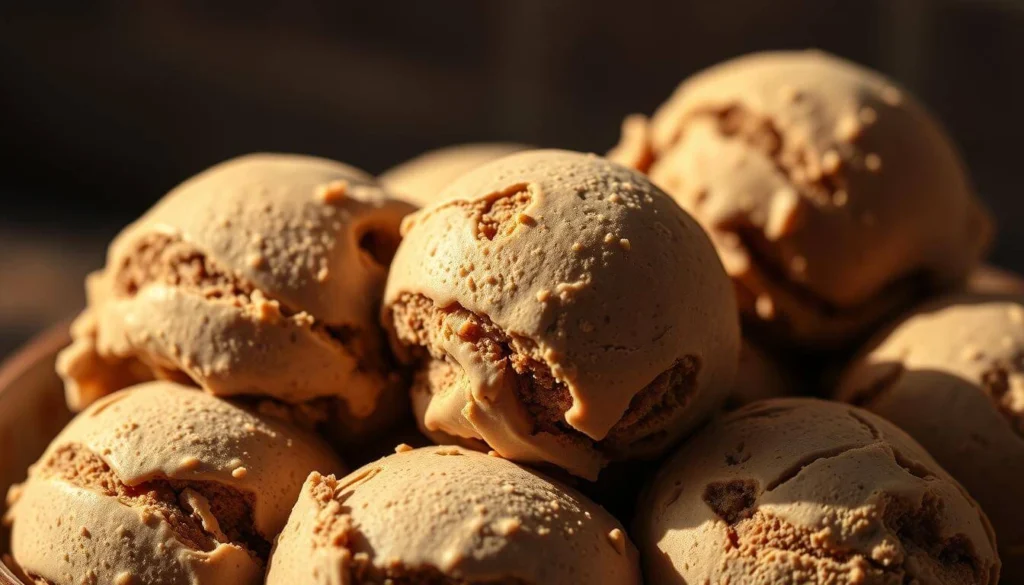
Common Myths About Coffee Ice Cream and Caffeine
Many people don’t know the truth about coffee ice cream and caffeine. It’s important to know the facts about your favorite treat.
Debunking Misconceptions
There are many myths about caffeine in coffee ice cream. Let’s look at a few:
“All Coffee Ice Cream Contains Caffeine”
This isn’t always true. Some coffee ice creams have caffeine, but others use artificial flavoring or decaffeinated coffee. This means they have little to no caffeine.
“Coffee Flavor Always Means Caffeine”
Just because it tastes like coffee doesn’t mean it has caffeine. The flavor can come from coffee extract, which might or might not have caffeine.
Scientific Facts vs. Popular Beliefs
Let’s compare the caffeine in different coffee ice creams:
| Brand | Caffeine Content (mg per serving) | Type of Coffee Used |
|---|---|---|
| Brand A | 20 | Regular Coffee |
| Brand B | 0 | Decaffeinated Coffee |
| Brand C | 5 | Coffee Extract |
Knowing the facts helps you choose coffee ice cream wisely. This is important if you’re watching your caffeine intake.
Conclusion: Enjoying Coffee Ice Cream Responsibly
Now you know how much caffeine is in coffee ice cream. This knowledge lets you enjoy it without worrying about side effects. The caffeine amount can vary, so it’s good to be careful.
When picking a coffee ice cream, look at the brand and how it’s made. These things can change how much caffeine it has. Check the ingredients to understand what “coffee extract” or “coffee” means. This helps you know how much caffeine you’re getting.
If you love coffee or just enjoy coffee ice cream, knowing its caffeine content is key. It helps you keep your diet balanced. So, go ahead and enjoy your favorite coffee ice cream, knowing you’re making a smart choice about caffeine.
FAQ
Does coffee ice cream contain caffeine?
Yes, coffee ice cream can have caffeine. This depends on the ingredients and how it’s made. The caffeine amount varies a lot between brands and types.
How much caffeine is in coffee ice cream?
Coffee ice cream’s caffeine can be very little in some brands or a lot in others. On average, it might have 20 to over 100 milligrams per serving.
Is there a difference in caffeine content between commercial and artisanal coffee ice cream?
Yes, there’s a difference. Artisanal ice creams might have more caffeine because they use stronger coffee. Commercial brands might use less or decaf to have less caffeine.
How does the caffeine in coffee ice cream compare to a cup of coffee?
Usually, a cup of coffee has more caffeine than ice cream. But, it really depends on the coffee and ice cream you’re comparing. Serving sizes and how they’re made also matter.
Can I make coffee ice cream at home with controlled caffeine levels?
Yes, making it at home lets you control the caffeine. You can pick the coffee or espresso type and how much to use, including decaf.
What should I look for on the label to determine if coffee ice cream contains caffeine?
Look for coffee, espresso, or coffee extract on the label. These usually mean there’s caffeine. But, the amount can vary. Check the nutrition label or ask the maker for caffeine info.
Are there health considerations I should be aware of when consuming coffee ice cream?
Yes, some people should be careful. This includes kids, pregnant or nursing women, and those sensitive to caffeine. It’s good to watch how much you eat and talk to a doctor if you’re worried.
Can consuming coffee ice cream affect my sleep?
Yes, eating coffee ice cream before bed can mess with sleep. Caffeine is a stimulant that can keep you awake or make sleep poor.
Are there any benefits to consuming coffee ice cream with caffeine?
Caffeine in coffee ice cream can make you feel more alert or improve your mood. But, these effects are stronger with more caffeine, like in a cup of coffee.
From Bitter To Balanced: How To Mix Cream And Americano The Right Way
Find the Best Coffee Beans for Your Brew
How to Choose the Best Coffee Maker for Your Needs
How to Make Breve Coffee at Home: Easy Recipe Guide 2025

